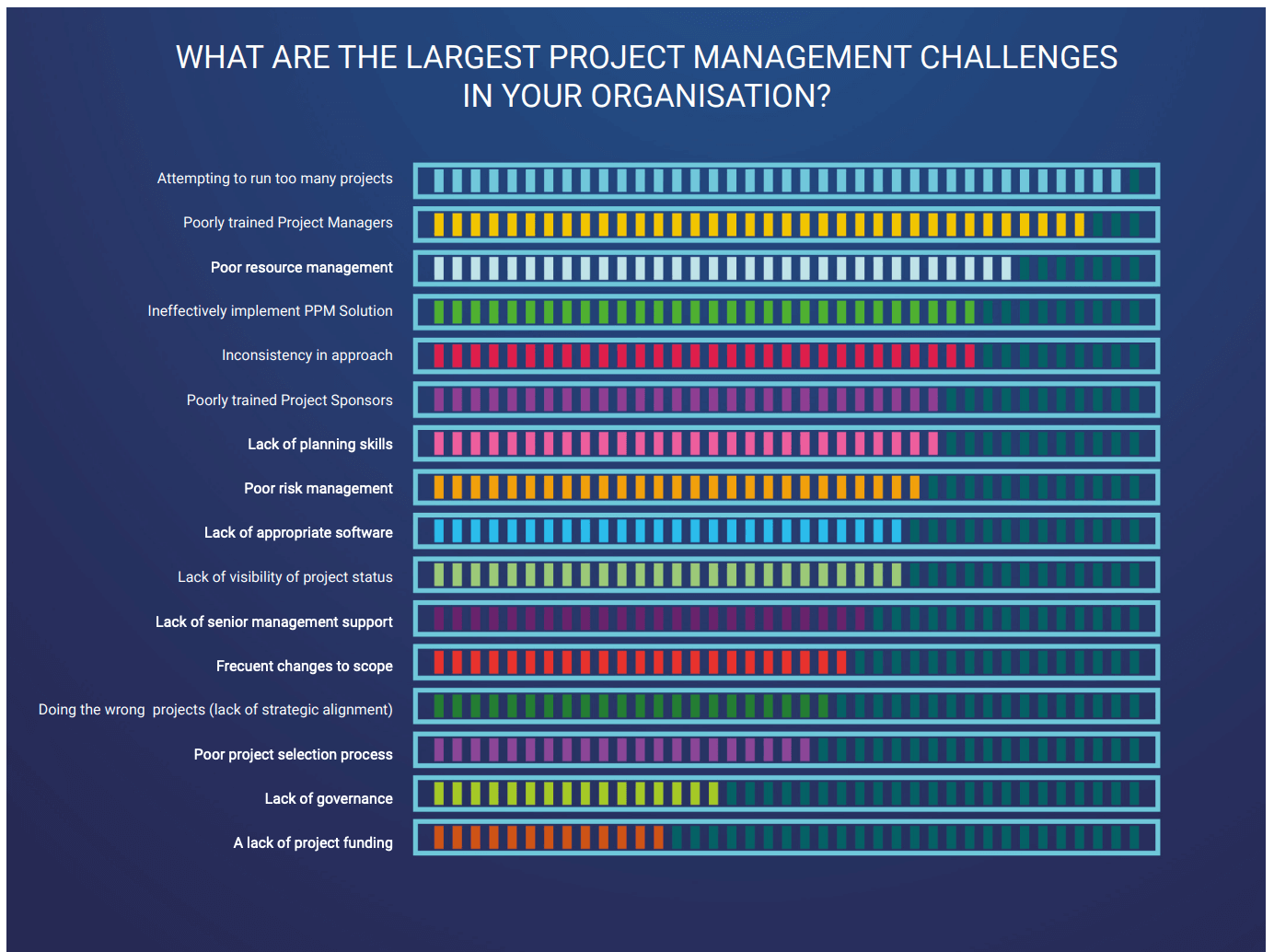资源日历--用一个工具管理整个团队
资源日历(或项目管理日历、或项目规划日历、资源规划软件)可让您更有效、更高效地规划、管理和分配资源--尤其是如果 Microsoft Excel 在您的项目中发挥了主导作用。
如果您在问自己什么是资源管理,那您就问对人了。在项目管理中,你不仅要管理交付项目所需的任务。如何规划、组织和管理团队对项目的成功有着重要影响。无怪乎,遵循资源管理的最佳实践会给工作场所带来真正的改变。
这篇文章会给你带来什么?
因为我们希望揭示项目资源管理的本质,所以我们需要介绍一小段学术对话,旨在启发与我们的主题相关的术语。
但是,这些争论还有另一个原因。如果不清楚地了解构成项目资源管理的主要元素和因素,任何人的决策都会面临更大的出错风险。这些错误与项目内部的流程有关,甚至与选择用于增加项目资源管理的软件有关。

有了大局观,你就不会迷失在概念的迷宫中,也不会不清楚从根本上支持项目管理的知识领域之间的联系。
信息技术项目管理、 营销项目管理房地产行业的项目管理,或 创意机构项目管理 - 无论如何,也无论你在 "项目管理 "一词前插入什么行业,其阶段、流程和步骤大多是相同的。但是,在你了解它之前,必须先做一点介绍。
我们知道,人们在看到图片或例子时会学得更快--首先可以通过感官和眼睛捕捉到一些东西。因此,在对下面定义中每个术语的含义提出大量问题之前,让我们先从项目管理家族中富有想象力且易于改编的例子开始。
从不难开始,花的时间更少:

总之,每当你想到 "项目 "时,你就必须了解有多少人、技能、分包商、工具和安排包含在项目中。要完成项目的每个插图,需要多少资源、依赖关系、小步骤、无数任务和时间表?
继续我们的话题,是时候研究一下定义了。那么,让我们从更容易理解的东西开始吧。让我们想象一下,你和孩子聊天,想向他描述项目管理的含义。在这种情况下,你可以很容易地引用来自 projectmanager.com 的定义:
项目管理是一门规划、执行和完成项目的学科。
上述理解将项目管理视为一个过程,并将其分解为 3 个步骤。当然,每个步骤都包含其他几组要素、流程、任务,以及与每个步骤相关的挑战(总是被低估,总是不可预测)。
但这只是项目管理生命周期的一个非常简化的版本,因为专家们就是这样命名这个过程的。最流行的是包含 5 个阶段的版本。PMI 开发的版本包括构思和启动、计划、执行、绩效/监控和项目收尾。

但这个定义并没有提出 "谁 "的问题。具体来说,就是人、专家及其能力、经验或成熟度。
根据我们在这里经常提到的同一个 PMI,他们提出了一个定义,强调了每个项目背后的一些东西。它与人有关,从项目经理到项目承包商,以及参与项目的劳动力。他们不仅是项目的安排者,也是被选中参与项目某个阶段并被分配任务的人。
套用他们的话说,项目管理就是利用 特定的知识、才能、技能、设备、工具、方法、流程和技术,以提供 "对人有价值 "的东西。
正如我们所看到的,这里更多的是能力(也包括软能力),是掌握信息和实施知识的能力。或者--用激励图书馆里的一句话来说--把思考变成行动,把事情做好。
在本章的摘要中,我们使用了项目管理协会的主张。这不是最容易记住的,甚至也不是最容易理解的项目管理定义,但读完上文,我们不难想象作者的想法。但是,有一点我们并不赞同。尽管如此
项目管理是应用流程、方法、技能、知识和经验,在商定的参数范围内,按照项目验收标准实现特定的项目目标。项目管理的最终交付成果受限于有限的时间范围和预算。
我想说几句。我们看到了一些与之前所提建议的相似之处,所以就不多说了。新颖之处在于有限的时间和预算以及验收标准。从最后一条开始,你的客户通常会有一些期望,他希望看到什么结果,应该如何工作,应该如何帮助解决他所面临的挑战。他不能接受你的工作结果。然后呢?
但这很难自相矛盾--验收标准可以使项目持续的时间比设想的要长。但是,我们不能同意这样的说法,即预算和时间是使领导项目成为合格的项目管理的条件。

有限的时间范围和预算将项目管理与单纯的管理区分开来 [上图 = 通过项目资源管理系统对多项任务的时间跟踪概览]
任何人都知道,任何董事长、老板或决策者在做任何项目时,最后要考虑的两个方面就是前面提到的时间和预算--因为它们不是无限的。但唯一的投资回报,即在预期时间内的预期回报,对企业决策的影响比其他任何因素都要大。而在许多企业看来,企业的根本就是钱。因为,如果你有足够的资金,你就不必做出仓促的决定,不必等待竞争对手为争夺下一个客户而做出的举动。
如果我们同意最后一种说法,我们就不能同意项目管理是 "管理 "之外的另一种东西的说法,这表明两者之间的关键区别在于,项目管理有最终的交付成果和有限的时间跨度,而管理则不同,它是一个持续的过程。
我们不确定是否只能这样做。企业的目标是拥有众多客户,尤其是能够让企业运转的客户数量吗?企业是否需要与潜在客户持续沟通?市场营销部门是否在规定时间内执行较小的任务或较大的项目,以改善沟通、增加网站访问量和潜在客户数量?负责市场营销和沟通的人员是否每月或每年都要汇报一次工作成果?
您现在了解项目资源管理的重要性了吗?

您已经了解了很多项目管理方面的知识,因此无需再了解更多。我们也已经知道 始终 在项目管理生命周期的 5 个阶段中找到项目资源管理的位置。
这是为了我们调查中最闪亮的明星--项目资源管理。我们已经知道项目意味着什么。 那么,有哪些资源呢?
感谢 APM 知识体系我们知道,资源可以理解为很多方面--人员(及其技能),也可以理解为资金、机械、材料、技术以及实现预期结果所需的其他任何东西。也可以说,资源就是完成任务或项目所需的一切。
当然,从许多企业,尤其是服务型企业的角度来看,资源管理的核心是人。人和他们的技能。
对他们来说,项目资源管理就是
(......) 获取、分配和管理项目所需的资源,如个人及其技能、资金、技术、材料、机械和自然资源。资源管理确保内部和外部资源在预算范围内按时得到有效利用。
这个定义并不是最简单的定义,因为它的用词模棱两可,因此可以用来写学术论文。但在本博客上却不是这样。在 Projectmanager.com 上,我们可以直截了当地了解它。不谈质量、要求和利益相关者的期望,甚至不谈时间和预算。
资源管理是规划、安排和分配资源以完成项目的过程。

良好的资源管理可使正确的资源在正确的时间用于正确的工作。 而资源管理人员的职责是--套用 APM 的说法-- 确定所需的资源(具有相关技能和经验的员工) 作为规划的一部分,确定何时需要资源。
正如我们所看到的,一般来说,这些定义--不包括它们的表述形式--都是相似的。如果我们试着比较一下项目资源管理的定义,看看它们有什么共同点,就会更有启发。好吧:
综上所述,项目资源管理无疑是项目管理过程中要求最高、最具挑战性的要素。一般来说,它的作用在于规划、组织、控制和衡量人们的工作。
简单地说,项目资源管理就是最有效地利用有限的可支配资源。或者--用实际情况来说--最大限度地利用现有资源--事先确定并审查适当的技能--在预期时间内完成项目并取得预期成果。
为了避免冗长的介绍,您必须知道,对于某些项目经理和学术代表来说,上述 3 个术语是分开理解的,每个术语都有自己的含义。
但对有些人来说,资源调度和资源分配的含义是一样的,都是资源管理这一更大范畴的一部分。但在许多关于我们主题的资料中,也可以找到将 "资源管理 "和 "资源调度 "等同起来的定义(请查看维基百科的定义)。因此,是时候解释一下了。

我们同意 Saviom 公司(我们在项目资源管理系统市场上的竞争对手)的观点:
资源分配,又称资源调度,是指在特定时期内为各种活动确认和分配资源
转眼间就可以看出,这个定义也可以作为资源管理的定义。不是吗?尽管如此,在本文中,我们还是试图保持项目资源管理及其整个过程包含调度和分配两个部分的顺序。
我们可以继续讨论细微差别的定义,但这不是目的。本章的目的是让大家更广泛地了解与相关术语有关的术语考虑因素和挑战。
A.雇员的估计工时与实际工时
项目是否按计划进行--这是每一个项目经理脑子里一直存在的问题。将假定的估算值(如员工在某项任务上必须花费的工时)与实际跟踪工时进行比较,是检查进度的一种方法。有了这种方法,你就能发现项目延误的早期迹象,并在当前项目或未来项目中做出一些改变。

B.每个团队成员的估计成本与实际成本(资源成本差异)
团队工作产生的成本是另一个迫使项目负责人深入思考的因素。好的项目资源管理系统可以为每个团队成员分配每小时甚至每天的费率,并为每个团队成员的构成分配相应的费用。 项目成本跟踪 根据他们和团队的工时表编制报告。

C.计费工时与非计费工时
项目中的非计费工时和计费工时的划分有助于跟踪公司的盈利情况。查看团队成员在会议、行政任务等活动上花费的时间。
D.资源利用率/员工利用率
资源利用率是公司追踪的最重要的绩效关键绩效指标之一。毕竟,你不希望你的团队超额预订或过度工作。否则,任何人都不应该没有任务。有 2 种计算方法 资源利用率您应该在项目生命周期的两个不同阶段使用它们。

A.难以获得资源和资源库的能力
项目数量越多,涉及的员工人数就越多。员工人数越多,就越难快速找到合适的员工分配到项目中。充足的项目资源规划系统的作用就是帮助寻找具有预期技能、成熟度、经验、能力、地点、成本状况、时区等的资源。

B.缺失资源的性能概述
衡量生产率仍然是企业面临的主要挑战,无论是新企业还是传统企业都是如此。工作时间分析--包括生产性和非生产性时间、员工在特定任务上花费的时间跟踪--有助于工作优化、时间和预算预测。

C.时间安排冲突
时间安排冲突 即使在组织严密的公司里,这种情况也并不罕见。特别是在软件公司、广告公司和其他以服务为导向的公司中,即使只有几个项目经理在工作,他们也在寻找合适的资源。项目资源管理系统会对预订重叠和--从员工的角度来看--超额预订发出警告。

D.资源能力规划不足
规划资源容量可以避免最后一刻的延误。容量定义了可用于执行特定任务的资源。
 如果你能在预算范围内按时交付项目,那么你就走在了正确的道路上。很多组织在项目初始阶段都没有概述资源能力,因此很难规划资源分配。
如果你能在预算范围内按时交付项目,那么你就走在了正确的道路上。很多组织在项目初始阶段都没有概述资源能力,因此很难规划资源分配。
可以通过资源跟踪来分析资源能力。多亏了一些带有项目管理工具的万能资源管理工具,才能缓解这一难题。
根据团队规模、公司概况和所遵循的项目管理方法,您可以选择各种资源管理工具。事实上,在开始阶段,您甚至可以使用简单的电子表格(不过我建议您不要这样做,因为随着业务的发展,电子表格可能会变得无效)。
总结本章,理想情况下,一个适当的 资源管理工具 应包括一个时间表(如简单的 资源日历 视图)、资源的可用性、当前预订情况和工时表。
自定义类别或标签也很有帮助,因为它们可以更方便地导航到当前需要的资源,按特定角色或项目过滤视图等。
最后,您可能希望选择一款具有集成报告部分的工具,这样您就可以轻松地使用所收集的数据来分析 团队工作量, 项目预算或公司的投资回报率。
视角越全面(但也越清晰),你就能从中获得更好的见解。
来自人力资源行业公司 betterteam.com:
资源经理协助项目经理进行人力资源规划和人员分配。他们确定公司满足项目人员需求的能力,为项目分配人员,并招聘新员工。他们还可以管理工资单和培训员工。
为了更直观地展示本章的主角--资源规划员--,让我们进行一些比较。这种比较基于资源管理人员和项目管理人员之间的简化差异。因此,项目经理是在项目层面上开展工作的--他们协调一组项目(大多相互关联)或仅仅一个项目。他们负责让项目团队完成项目。而资源经理则在公司层面开展工作。为多个项目选择、分配和匹配技能适当的资源。

克尔斯滕-伯德(Kirsten Bird)口中的项目经理协会(Association for Project Managers)提出了我们这颗星星的意义。
作为规划的一部分,项目专业人员必须确定完成工作所需的资源,并通过时间安排确定何时需要这些资源。
我们要特别强调的是第一部分 "必须确定......"。为什么它如此重要?首先,但不是最重要的,因为它是起点。在谈及资源管理的各个方面时,大多强调的是其核心的调度。在这里,我们看到了良好调度的基础--软技能,尤其是与人打交道的好眼力和好感觉。
现在是 资源经理的职责:
项目管理知识体系》(PMBOK)规定的知识领域。
考虑到员工的技能和可用性,您应该有一份准备好分配给项目的员工名单。有了已选定要参加项目的员工名单,您就可以在自己选择的工具中预订他们。

由于 资源分配 人力资源管理是一个充分利用现有资源的过程,因此应跟踪其绩效和利用情况。人力资源管理的这个方面将帮助你避免资源利用不足或过度,并防止员工倦怠。
资源分配的其他好处包括
你要关注人力、技术、机械和其他资源完成了多少工作,同时还要关注他们投入的时间。你要特别关注 "利用不足 "或 "利用过度"(总体分配)的资源。
如果能够调整项目进度表以满足项目截止日期的要求,就可以使用资源分配。要使用资源分配来修改进度表,可根据资源的可用性来划分或合并活动,这样就不会出现项目团队成员利用率不足或过剩的情况。

资源经理如果工作出色,对数字了如指掌,就能以合理的信心预测其团队在一段时间内能完成多少工作。这样,团队和公司就能准确地为即将到来的任务做好准备和计划。
既然知道了什么是资源管理,就需要制定计划。要想有效地管理多个项目中的资源,你需要为每个项目制定一个高层次的计划。
高层规划 是项目经理对项目的看法:
在项目资源管理中,高层次计划有助于回答以下问题:"要在预算范围内按时成功交付项目,我需要哪些角色?
在制定高层次计划时,您还不必列出所有任务的详细清单。相反,你需要包括
有了高层次的计划,你就能更好地了解资源能力和项目范围。
有了高层次的计划,你就能对交付项目所需的条件有一个全面的了解。我们也已经说过,它可以帮助你了解交付项目需要哪些角色。但是,在将这些角色分配到新项目之前,您究竟该如何确定他们呢?
根据国际知名的项目管理协会制定的标准,PMBOK®、 资源规划 就是 "确定应使用哪些资源(人员、设备、材料等)以及每种资源的数量来开展项目活动"。
使用 工作分解结构您可以通过估算的持续时间或历史数据来确定:
一旦列出了可以预订而不会造成日程冲突的员工名单,就可以将他们分配到项目中了。
有了所有项目的高层次计划,以及目前如何使用资源的想法,你就知道了自己的能力和公司的管道。
现在,当贵公司赢得新项目时,您可以快速回答以下问题:
项目入职 是 有效的资源管理.向团队成员介绍他们将参与的项目的目标、目的和交付成果。这种策略将提高 项目透明度 并帮助您作为项目经理与团队建立信任。
这部分流程包括 4 个步骤:
要使项目的时间表、可用资源和范围保持一致,就要使用资源计划表。这一点至关重要,因为它能告诉你何时需要特定的资源,这样你就可以相应地计划预订。在为项目分配人员时,切记要关注资源的可用性。
有几个 项目调度技术 您可以使用:
"(《世界人权宣言》) 关键路径法 (CPM) 是一种用于确定项目可能需要的最长完成时间的技术。通过列出所有任务并将其分为关键任务和浮动任务,您可以计算出时间轴并标出任务之间的依赖关系。
要使用 CPM 方法创建任务流程,您需要
计划评估和审查技术 (PERT) 是一种类似于 CPM 的方法,但它使用加权平均工期而不是估计工期来计算可能的工期。
使用 PERT,您还必须创建一份任务列表,列出任务之间的依赖关系,包括里程碑和每项任务的预计持续时间。根据这些信息,您可以按三个置信度来估算项目的时间表:

快速跟踪是项目经理用来确定哪些任务可以同时处理的一种简单的日程安排技术。了解了项目任务之间的依赖关系,就能知道哪些工作需要先完成其他任务。同样,您也可以列出至少可以部分重叠的任务,从而加快项目的交付速度。
如果使用快速跟踪无法节省所需的时间,您可以使用崩溃技术。但这样做是有代价的,因为你需要增加时间来加快项目进度。这样做的方法是,例如,增加带薪加班时间--最终项目成本会增加,但仍能在截止日期前完成。
根据您通过实施资源管理收集到的数据,如员工的预订时间、时间条目和可用性,您可以衡量他们的绩效和其他业务指标。
衡量资源利用率 只需遵循一个简单的公式:
资源利用率 = 忙碌时间/可用时间
无论是使用电子表格还是资源管理工具,您都可以用它来比较预订与可用性。由此得出的衡量标准会告诉你,你是否有效地利用了员工的时间,或者他们是否被过度利用或利用不足。
同样,您也可以使用这一指标来比较计费时间和员工记录的工作时间。这样,您就可以确定自己是否有效利用了资源。
收集预订和工时单数据时,您可以 计算项目预算也可以。您甚至可以用它们来跟踪整个项目的预算,看看是否在预计成本范围内。

例如,您可以将预订与时间表进行比较,查看记录的工作时间是否与您的估算相符。然后,了解员工的小时费率,就可以计算出他们在项目上花费的时间的实际成本,从而确定实际预算。
同样,您也可以使用电子表格来完成这项工作,但使用资源管理工具会更方便,因为该工具具有以下功能 报告功能.
项目 资源管理节省资金.虽然乍一看似乎很复杂,但一旦掌握了它,其实并不难。让它成为团队项目管理流程的一部分,并始终利用正确的资源和时间。
通过实施资源管理系统,您可以省去很多麻烦。Teamdeck 就是这样一个例子 项目资源管理软件该工具集资源调度、时间跟踪、休假管理和自定义报告于一身。使用该工具,您可以轻松添加预订、记录时间条目、管理和调整日历,并在数据基础上计算您选择的指标。
想成为一名 高效资源管理器?寻找 项目经理的免费资源?你想知道 企业选择 Teamdeck 的原因 作为其项目资源管理的邮件解决方案?还是不知道为什么项目 资源管理很重要?